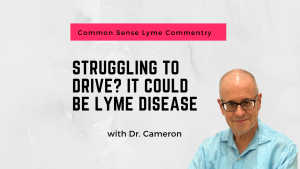
Lyme disease can mimic menopause symptoms in women—fatigue, night sweats, and mood swings aren’t always hormonal.
One of my patients came to me in her late 30s, convinced she was going through early menopause. She had all the classic symptoms—intense fatigue, night sweats, brain fog, anxiety, irregular periods, and mood swings. Several doctors told her it was hormonal. Some ran labs. Others offered reassurance or stress reduction tips. None looked further.
She was told to wait it out. But while she waited, her symptoms grew worse.
When Lyme Disease Mimics Menopause Symptoms in Women
Lyme disease and early menopause can look nearly identical. In women, Lyme disease may present with profound fatigue, dysregulated temperature, emotional shifts, and disrupted menstrual cycles—all of which can be confused with perimenopause.
These symptoms are often mistakenly chalked up to hormonal fluctuations. But when standard hormone treatments fail, it’s time to look deeper.
Babesia, Night Sweats, and the Hormone Trap
One of the most common symptoms I see in women with Babesia—a malaria-like parasite transmitted by ticks—is night sweats. These aren’t mild flushes; patients describe drenching, disruptive, soaking sweats that wake them up at night.
In women in their 30s or 40s, this is often misattributed to early menopause. But Babesia should be considered when night sweats are accompanied by:
-
Shortness of breath or “air hunger”
-
Heart palpitations
-
Chills or intermittent low-grade fever
-
Dizziness, especially with standing
-
Crushing fatigue unrelieved by sleep
Babesia does not respond to doxycycline. It requires specific antiparasitic treatment—usually atovaquone with azithromycin, or newer options like tafenoquine in appropriate cases. Recognizing this pattern can make the difference between years of suffering and true recovery.
A Story I’ve Seen Too Often
One patient described it this way:
“I kept saying, ‘This isn’t normal.’ But every doctor told me it was just hormones. I started to doubt myself. It wasn’t until I was treated for Lyme that I finally felt like myself again.”
Her symptoms didn’t respond to hormone therapy or lifestyle changes. When we tested further, she was positive for Lyme disease and Babesia.
This pattern isn’t rare. I’ve seen women misdiagnosed, minimized, or ignored—sometimes for years.
The Johns Hopkins Lyme Disease Research Center reports that women often experience more severe or atypical Lyme symptoms, are more likely to be misdiagnosed, and face greater illness invalidation than men. Hormonal and immune differences may play a role.
Lyme Disease and Early Menopause Symptoms Can Overlap—but Need Different Treatment
When symptoms like night sweats, fatigue, mood swings, and irregular cycles are caused by tick-borne infections, hormone therapy alone often doesn’t help. That’s because the root issue isn’t hormonal—it’s infectious.
In my practice, I’ve seen women improve not with estrogen, but with targeted antimicrobial treatment for Lyme disease and co-infections.
Here’s what that treatment can include:
-
For Lyme disease:
A longer course of antibiotics, such as doxycycline, amoxicillin, or cefuroxime, often in combination if symptoms persist or relapse. -
For Babesia:
Antiparasitic treatment with atovaquone and azithromycin, or tafenoquine in select cases. Babesia requires a different approach than Lyme and won’t respond to doxycycline alone. -
For Bartonella:
Targeted antibiotics such as doxycycline, azithromycin, rifampin, or clarithromycin, depending on symptom severity and treatment response. -
When symptoms persist:
I may recommend combination therapy based on patient response. Clinical judgment is especially important when lab tests are negative but symptoms clearly suggest a tick-borne illness.
These infections can disrupt the endocrine and nervous systems, producing symptoms that mimic early menopause but don’t follow typical patterns—and don’t resolve with hormonal treatment.
The key is recognizing that what looks like a hormonal shift may actually be a systemic infection requiring targeted antimicrobial therapy.
What I Tell My Patients
If you’re in your 30s or 40s and struggling with symptoms that feel hormonal but aren’t improving with standard therapy, don’t assume it’s just menopause. And don’t let others assume that either.
Ask the deeper questions. Consider Lyme disease and co-infections. And if needed, treat the underlying infection—not just the symptoms.
Lyme disease can mimic menopause symptoms in women—and when it’s missed, the cost is more than physical. It’s emotional, personal, and preventable.
Related Articles:


